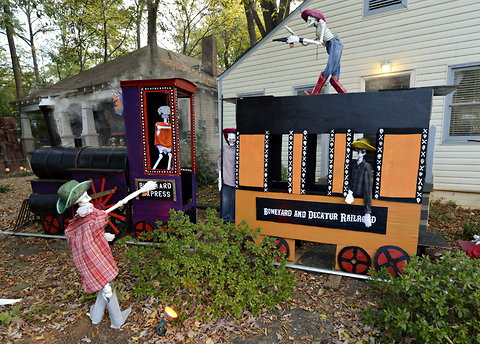 European Pressphoto AgencyA Halloween display in Decatur, Ga.
European Pressphoto AgencyA Halloween display in Decatur, Ga.
Halloween used to be a one-night event. When I was a kid, my mother helped me and my brothers put together costumes — usually, homemade. We carved a pumpkin. Maybe we bobbed for a few apples. We went trick-or-treating in our neighborhood. We tried to con each other into trading candy we liked better. And that was it, until the next year.
Times have changed. Halloween has morphed into days — even weeks — of October parties, festivals and candy giveaways that strain budgets and overload youngsters with more sweets than my Milky Way-addled childhood brain could ever have imagined. There’s no need for sibling bargaining, when everyone has an overabundance of treats.
I find this “holiday creep” annoying, not to mention potentially fattening, as well as expensive. The average American will spend nearly $80 on decorations, costumes and candy this year, up from $72 last year, according to the National Retail Federation. Total Halloween spending is expected to be about $8 billion.
It’s not that the organizers of all the extra events aren’t well intentioned. Last week, my children attended a “fall festival” (it involves costumes and candy, but is apparently named so as not to put off those who object to Halloween). It was a fund-raiser for a very deserving local charity. But bringing two children, plus a friend, totaled $60 for the night. (I realize I have free will, and could simply have chosen not to go. But it gets harder to sit out when excess celebration is becoming the norm, and all of your children’s friends are attending, too).
Today, my younger child had a celebration at school. (Call me a party pooper, but I didn’t bake cupcakes.) And this afternoon, my offspring will go trick-or-treating at their dad’s workplace, where employees elaborately decorate their cubicles for the holiday to entertain the kids. Finally, at dusk, we’ll venture out into the neighborhood for the actual door-to-door event.
In addition to being tiring, the cost of all this partying adds up. Unless you’re adept at homemade costumes or have time to browse thrift shops, you’ll pay about $15 to $20 per child for an out-of-the-bag get-up, and three to four times that if you order from a higher-end catalog. If your child is the messy type, you may need more than one costume for the different events, which adds to the cost. (My youngest was a vampire for the fall festival, but agreed – whew! – to recycle a Pocahontas costume from a school play for the “official” trick-or-treat outing.) This year we’re pet owners, so my kids begged for a pumpkin sweater for the dog. (O.K., I do have to admit that she looks really cute).
By the time we’re finished, we’ll have shopping bags full of candy. This is the situation that leads parents to turn to the “Halloween fairy,” who takes away excess treats in exchange for a toy, which adds to the cost further. But wouldn’t it make more sense to scale back the excess in the first place?
How do you keep the lid on Halloween, without appearing to be a killjoy?
Article source: http://bucks.blogs.nytimes.com/2012/10/31/wrestling-with-halloween-cost-creep/?partner=rss&emc=rss